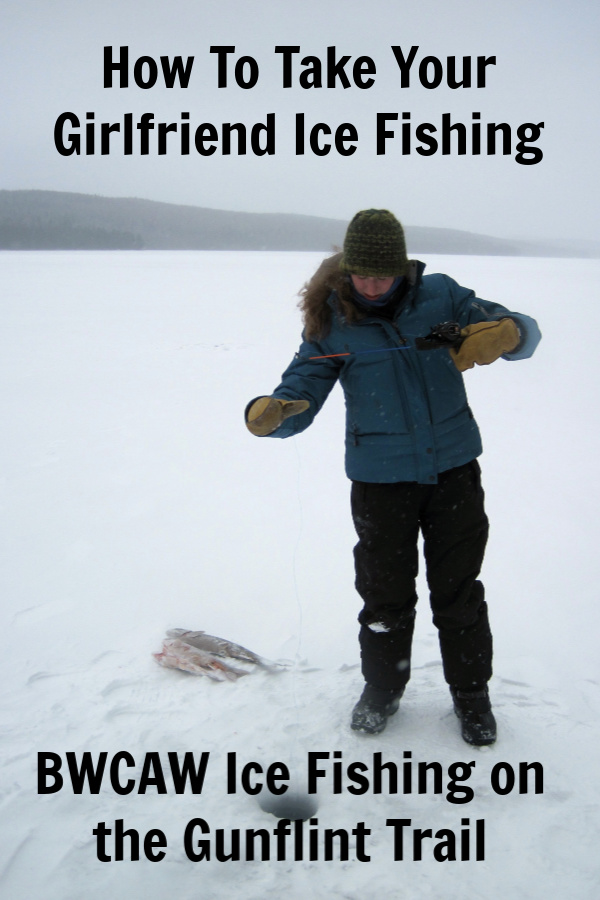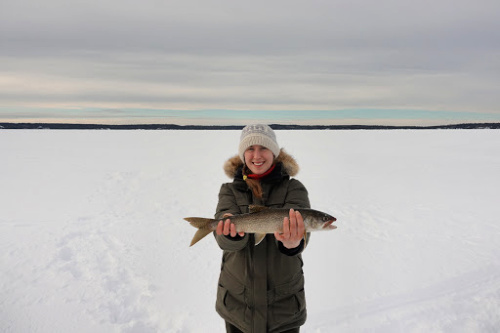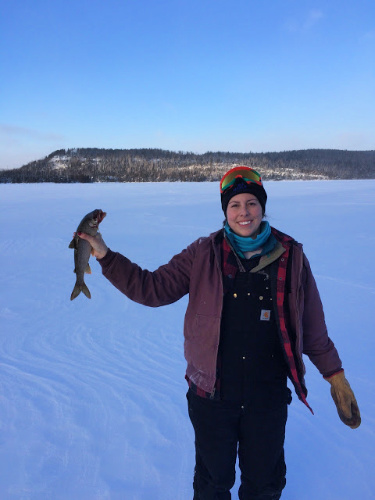
First things first, let’s just clear the air by stating that the following blog post is not exclusively about taking your girlfriend ice fishing. It’s about taking your girlfriend, boyfriend, best friend, or any other slightly reluctant adult ice fishing for the first time. We were simply inspired by the recent video on Jay Siemens’ Youtube channel about “What NOT to do when you take your girlfriend ice fishing.” This is not a gender specific post. Whew! Moving on . . . .
As a girlfriend who has been taken ice fishing, I have a little insight on this subject. I went ice fishing a grand total of once as a child (it was cold, we caught one fish) and it wasn’t until I was in my mid-twenties that ice fishing became a regular winter activity for me. Since I wasn’t raised by anglers, I’m not sure I could have really explained what a tip-up was on that first “grown-up” ice fishing trip, so the ball was firmly in the court of the person taking me ice fishing to show me it was an experience worth repeating. Luckily, Andy was up to the challenge, and while I might not always be the most cheerful ice fishing companion (see photo below), for the last decade, I’ve accompanied Andy ice fishing on a fairly regular basis.

If you’re looking to turn your BFF into an IFFF – that’s short for “Ice Fishing Friend Forever – here are our best tips to get them enjoying ice fishing so that they’re actually willing to go ice fishing with you again (and again and again):
Action, action, action
The tips we go over in last year’s “The Best Ice Fishing Lakes for Kids” post are as applicable to adult first-timers as they are to kids. For that first ice fishing trip with your would-be IFFF, you want to choose a lake that you’re confident can deliver fast results. We know you’re excited to take your significant other out fishing, but now’s not the time to take them out to that one lake you need to bushwhack into that you’ve heard good things about but you’ve never actually fished. Take them to a lake you know well and to a spot that consistently delivers.
Don’t abuse their good nature
Here’s a scenario for you. Let’s say your significant other is really into running. You’ve watched them lace up their shoes religiously every other day, you’ve cheered them on at countless 5ks, and now they’re training for their first marathon. You’ve never run a mile, but you’re inspired. You mention in passing that you’d like to go running with them some time. They take you up on your offer and invite you along on their next run. Now are you more likely to going running with them a second time if they A) take you out on a five-mile tempo run with no water breaks or if they B) take you on a leisurely run/walk option around a couple blocks?
If your partner announces that they’d like to go ice fishing with you sometime, YAY! Now wield your power carefully. While you might suddenly have visions of that snowmobile-in ice fishing trip in Manitoba you’ve been dreaming of finally becoming a reality, now is not the time to start planning a multi-day ice fishing expedition. Nope, now is the time to carve out a couple hours on a sunny afternoon for a low-key, low-pressure first-time ice fishing trip. You want your partner saying, “hey that was pretty fun, when can we go again?” not “Can we go home now?”

There is such a thing as too much helpful advice
One of the best things you can do is rig up your partner’s rod with whatever tackle and bait you think works best for where you’re fishing and then letting them have at it. Maybe their jigging technique makes you cringe. Maybe you’re 100% sure they’re not dropping their line deep enough. Be conservative in how much advice you volunteer and don’t feel the need to coach them through every step. Sure, they might lose a couple fish on their way up to the hole before they totally get how to set the hook and keep tension on the line, but if they care, they will learn. If they don’t care, they’re not listening to you anyway, so save your breath. Let them ask the questions that will help them become better anglers and be okay with the fact that their techniques might differ from yours. Your way or the highway is not a good approach to ice fishing . . . or your relationship.
Fun vs. fish
Remember, they’re not going to come with you again if they don’t have any fun, so you might have to let go of a little fishing hubris. Don’t get caught up in fishing ultimatums that you might hold yourself to if you were fishing alone. This is not the time to declare “we never pack up until a full half hour after sunset” or “nobody goes anywhere until one of us catches a 10 lb trout.” Maybe you never keep fish, but your fishing partner is pretty keen to take the fish they just landed home for dinner. Let them! It’s supposed to be fun.
Consider latrine proximity
While this is a gender specific tip, there’s no getting around the fact that toileting in the woods is more of an ordeal for women, especially when bundled up for winter weather. If you happen to be a male taking a female ice fishing off the Gunflint Trail for the first time, it’s a nice gesture to select a fishing area that’s close to a Boundary Waters campsite so they can use the latrine if they prefer.

Choose your date carefully
You might be anxious to get out ice fishing as soon as the ice is safe, but if you’re looking to cultivate an IFFF, you might consider waiting to take that first ice fishing trip together until mid to late March. Along the Gunflint Trail, late March is the best time to go ice fishing because the longer, sunnier days knock down the snow and slush to make for easy lake travel and after the long winter, ice fishing in sunny 40 degree weather feels downright tropical and fantastic. Besides, nothing builds anticipation like having one great ice fishing trip in late March and then not being able to go again for another nine months.
Bring snacks and extra warm clothing
If this is the first time your partner has gone ice fishing, they might not know what kind of outdoor clothing they need to be comfortable ice fishing, or they just straight up might not own the right clothing. To avoid your partner getting literal cold feet, throw in some hand and feet warmers, an extra jacket or vest, a balaclava, and an extra pair of mittens. A hot thermos of coffee or hot cocoa to share is a good way to warm up and pass the slow time when the fish aren’t biting. Don’t forget some snacks!

